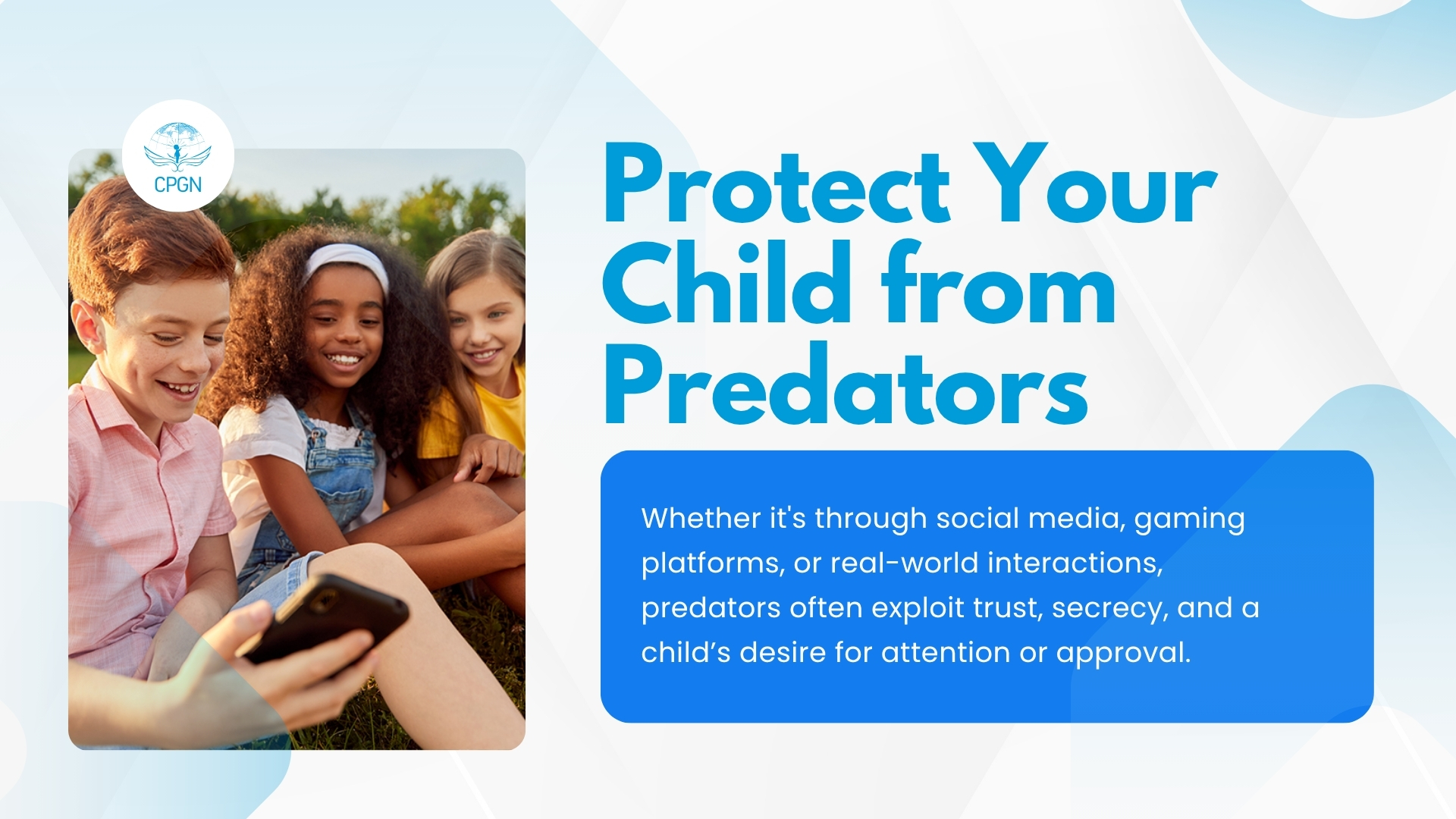How to Protect Your Child from Predators | CPGN
Learn practical steps to protect your child from predators online and offline. Understand the importance of communication, digital safety, and setting boundaries to keep your children safe.

How to Protect Your Child from Predators
In today’s digital world, the safety of children is more vulnerable than ever. As technology evolves, so do the methods used by predators, both online and offline. Whether it’s through social media, gaming platforms, or real-world interactions, predators often exploit trust, secrecy, and a child’s desire for attention or approval.
So, what can parents, educators, and caregivers do to protect children from predators? It’s not just about fear, it’s about empowerment. By fostering open communication, setting clear boundaries, and educating children on risks, we can shield them from harm.
In this article, we’ll explore practical, empowering steps that will help you protect your children from online predators, grooming, and exploitation.
Quick Summary:
- Build open communication: Talk regularly about online and offline experiences.
- Establish boundaries: Set rules for screen time and monitor online activity.
- Educate children on grooming tactics: Teach them how to identify predators and unsafe situations.
- Strengthen the digital environment: Use privacy settings and tools to monitor online activity.
- Supervise offline settings: Ensure adults and volunteers interacting with your child are vetted.
Understanding the Threat: What Is a Predator?
Before we explore how to protect your child, it’s important to understand what makes a predator. Predators, or offenders, are individuals who seek to exploit children for sexual, emotional, or financial gain. Predators can be strangers, but more often, they are individuals the child knows or trusts. They may manipulate, deceive, or threaten a child to gain control or compliance.
Types of Predators
Online predators:
These individuals use the internet, social media, or online games to target children. Grooming is a common tactic, where predators build trust with children to exploit them later.
Offline predators:
These individuals target children in real-world settings, such as schools, sports events, or within their own communities. These predators may seek private, unsupervised moments to manipulate or abuse the child.
Understanding these threats allows parents to take preventive actions to protect children from harm.
For more insights on protecting children, check out Teaching Children About Body Safety.
Practical Steps to Protect Your Child
1. Build Open Communication and Trust
Establishing a relationship of trust with your child is the most powerful tool in predator prevention. Encourage regular conversations about their daily lives, both online and offline. Ask about the apps or games they use, who they talk to, and how they feel about their online experiences.
- Create a safe space for dialogue: Let your child know they can speak to you if something or someone makes them uncomfortable — without fear of punishment or judgment.
- Teach about secrets vs. surprises: Explain the difference between safe secrets (a surprise gift) and dangerous secrets (anything that makes them feel uneasy).
According to Kidpower International, it’s important to teach your child that “safe secrets” are okay, but “unsafe secrets” should be shared with a trusted adult.
2. Establish Boundaries and Rules
Setting clear and consistent rules for your child’s internet use is key to keeping them safe online. Boundaries should be enforced, but also flexible enough to ensure trust.
- Family internet contract: Establish what apps and websites are okay to use, how much screen time is appropriate, and where devices should be used (e.g., no devices in bedrooms at night).
- Monitor and supervise: Regularly check your child’s social media accounts, friend lists, and privacy settings. Use parental controls and other monitoring tools to track activity.
- Teach them about online meetings: Make sure they understand they should never meet someone in person whom they’ve only spoken to online without your permission.
Learn more about online safety in this CPGN blog post.
3. Educate Your Child About Grooming and Manipulation Tactics
One of the most common tactics predators use is grooming. Grooming involves building trust with a child and manipulating them into compromising situations.
- Explain grooming behaviors: Teach your child that a predator may pretend to be a peer or flatter them, offer gifts, or ask them to keep secrets.
- Identify red flags: Help your child recognize when something feels “off” — such as when someone asks for personal information, pictures, or favors.
- Trust instincts: Encourage children to listen to their gut feelings. If they feel uncomfortable or someone is pressuring them, they should immediately close the conversation or seek help.
4. Strengthen the Digital Environment
The digital world has opened new avenues for child predators, but parents can take steps to ensure their children are protected online.
- Privacy settings: Use strong passwords for online accounts and set privacy controls on social media platforms. Encourage your child to be mindful of what they post and share.
- Monitor activity: Regularly check your child’s friend lists, chat history, and any private messages they receive.
- Teach about digital footprints: Remind them that online activity — photos, posts, and messages — can stay online forever and may be shared without their knowledge.
5. Supervise Offline Social Settings
It’s crucial to remember that online safety isn’t the only consideration when protecting your child from predators.
- Limit one-on-one unsupervised time: Ensure that adults and volunteers interacting with your child are properly vetted. For example, sports coaches or teachers should always be supervised by another adult.
- Teach body autonomy: Explain to your child that their body belongs to them. Encourage them to speak up if anyone makes them feel uncomfortable.
Warning Signs of Predatory Behavior

As a parent, it’s crucial to spot the warning signs early. Here are some red flags that may suggest predatory behavior:
- Secretive behavior: If your child becomes overly secretive about online activities or quickly switches screens when an adult approaches, it’s a potential warning sign.
- Excessive one-on-one attention: If a new adult or friend spends a lot of time alone with your child, offers gifts, or creates special privileges, it’s important to be cautious.
- Emotional changes: Watch for signs of anxiety, withdrawal, or reluctance to participate in regular activities, including school.
Global & Emerging Threats to Be Aware Of
In addition to traditional predatory behaviors, new technologies are creating emerging threats. AI-generated imagery and deep fakes are now being used to exploit children.
- AI exploitation: AI tools are being used to create exploitative images of children, making it crucial to stay informed on new digital threats.
- Social media evolution: Platforms that were once considered “safe” now allow direct messaging and chat rooms, making them common tools for grooming and exploitation.
UNICEF is actively researching these emerging threats and promoting digital literacy to help protect children online.
Empowering Parents and Protecting Our Children
Protecting children from predators requires vigilance, awareness, and trust. By educating your child, setting boundaries, and monitoring both online and offline activities, you can build a safe environment that empowers your child to speak up and protect themselves.
At CPGN, we are committed to advocating for children’s safety and providing resources that help parents and caregivers safeguard their children in a rapidly evolving digital world. Together, we can protect our children from harm and ensure they grow up in a world that supports their well-being and safety.
Join CPGN in our mission to protect every child’s right to safety. Learn more about identifying risks, empowering families, and fostering a community of support
FAQs
Start by fostering open communication with your child about online and offline safety. Set clear boundaries, monitor their digital activity, and teach them to trust their instincts when something feels wrong.
Look for changes in behavior, such as secrecy, anxiety, or reluctance to participate in regular activities. Also, be wary if they begin forming relationships with unknown adults or spend excessive time online without supervision.
If you suspect your child is at risk, take immediate action by opening a conversation with them in a non-judgmental way. If necessary, contact authorities or a child protection service to ensure your child’s safety.
Mark Schwartz
Our goal is to ensure the safety and protection of every child until it is achieved. Our goal is to support communities in protecting the future of children and promoting their welfare.
Quick Links

Our goal is to ensure the safety and protection of every child until it is achieved. Our goal is to support communities in protecting the future of children and promoting their welfare.
Quick Links
Copyright © 2025 CPGN. All rights reserved by Majnate LLP | Privacy Policy | Terms and Conditions
